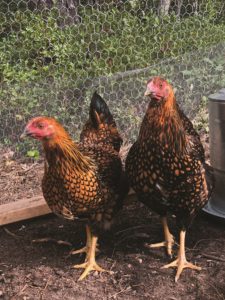When we became backyard chicken farmers five years ago, I had oodles of enthusiasm, but very little actual knowledge of chickens. I didn’t know, for example, that our six brand-new “babies” were soon to become — no, not hens, at least not yet. First, they would be pullets. Nor did I realize how surprisingly tiny their very first eggs would be.
A chick becomes a pullet, or “teenage” hen, at around 15 weeks. They start laying their first pullet eggs at about 24 to 26 weeks, and are called pullets until they reach full maturity around one year of age.
This spring’s Covid-19 lockdown turned many Outer Cape families into novice chicken owners, and those who started out with fluffy baby chicks in March or April now have adolescents on their hands. Don’t worry. While pullets share certain characteristics (like skinniness and still-forming bodies) with their human counterparts, chicken-teens are no more difficult to keep than their parents, and much easier to raise than when they were babies needing heat, extra hydration, special feed, and plenty of changes to keep their brooder clean.

A warning: some new chicken-parents, who started with chicks and now have pullets in their coops, may be in for a surprise if one of their hens-to-be suddenly starts to “doodle.” That’s the word our family made up for the raspy teenage sound a cockerel, or adolescent rooster, makes before he breaks into full voice.
Baby chicks are difficult to sex, and while some sellers promise only females, you often end up with at least one male, especially if you get your chicks very young. Once a cockerel has discovered that he can sing, he will practice with gusto every day, usually between five o’clock in the morning and noon and often even all the way until dusk.
As innocent as a cockerel’s call may sound at first, it has become a heartbreaking song to us, for no backyard farm with neighbors in the vicinity can keep a rooster and a good relationship with said neighbors. And, with few places to bring adolescent roosters, they usually end up in the frying pan. Enough said.
Once you have ruled out any cockerels in your juvenile flock, it’s time to start looking for those cute little pullet eggs. A well-built coop should include an egg box — one per six hens should be enough. Our now 16-strong flock often shares a single box, especially if a bossy broody mama — each flock usually ends up with one of this kind — hogs a box to herself. Now is the time to fill those egg boxes with inviting soft hay or, even better (if you want to spoil your ladies), sweet-smelling alfalfa. Both can be bought at most places that sell animal feed.
If your adolescents still have a mind of their own when it comes to where they choose to lay, you can add a pretty quartz egg to their box to show them the idea. For the most part they will get it, but you may end up with an independent-minded missy, who insists on choosing her very own spot. In that case, your best bet is to create a soft nest where she prefers to lay, as eggs laid on a hard surface are likely to break. Try your best to avoid broken eggs, especially in a new flock, because some chickens can develop a taste for eggs themselves, and then you’re out of luck when it comes to your own breakfast.
Once your pullets have discovered their box, they will practice laying in it, or on the stone egg, until one day — lo and behold! — you discover your first pullet egg. There is nothing more delicious than the very first egg from your first flock, so make sure to share it with everyone in your home, even if each person gets only a tiny bite. Pullet eggs taste just like their larger cousins, but the excitement that comes with their arrival is precious. And once your teens start laying, they won’t stop, at least for a while. But that is a story for another day.



